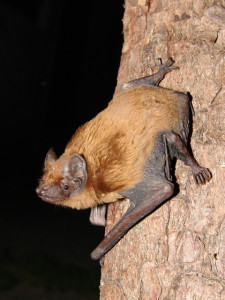 One of the regular inhabitants of deciduous forests and parks of Europe, Caucasus and Central Asia, the common noctule became an important asset in the research of seasonal migrations, thermoregulation, nutrition, echolocation and other biological peculiarities. The bat is relatively common here. This is a thermophile, and therefore it migrates south seasonally to winter.
One of the regular inhabitants of deciduous forests and parks of Europe, Caucasus and Central Asia, the common noctule became an important asset in the research of seasonal migrations, thermoregulation, nutrition, echolocation and other biological peculiarities. The bat is relatively common here. This is a thermophile, and therefore it migrates south seasonally to winter.
This is one of the larger bats – its body length is 61-64 mm, with the tail of 46-54 mm. Its wings are narrow and thin. The upper part is pale ginger or brown, with the under parts a bit lighter. All bat species are useful. These ones settle in the hollows of old basswood trees or poplars, gathering into small groups of 30-35 species. They sleep through the day, hanging upside down, and activate at twilight and through the night. The species do two foraging raids per night – one following the sunset and one before the dawn. Common noctules hunt in forest glades and edges. They are deft and agile in flight – they dexterously dodge obstacles in the way even in the dark. They prey on flying insects – beetles and butterflies – using echolocation to detect targets.
/ * The photos at lake.peipsi.org are cross-posted from commons.wikimedia.org and are used for familiarization purposes only. No commercial use of the photos is allowed. For more information about to use the photos see the originals on commons.wikimedia.org. /


